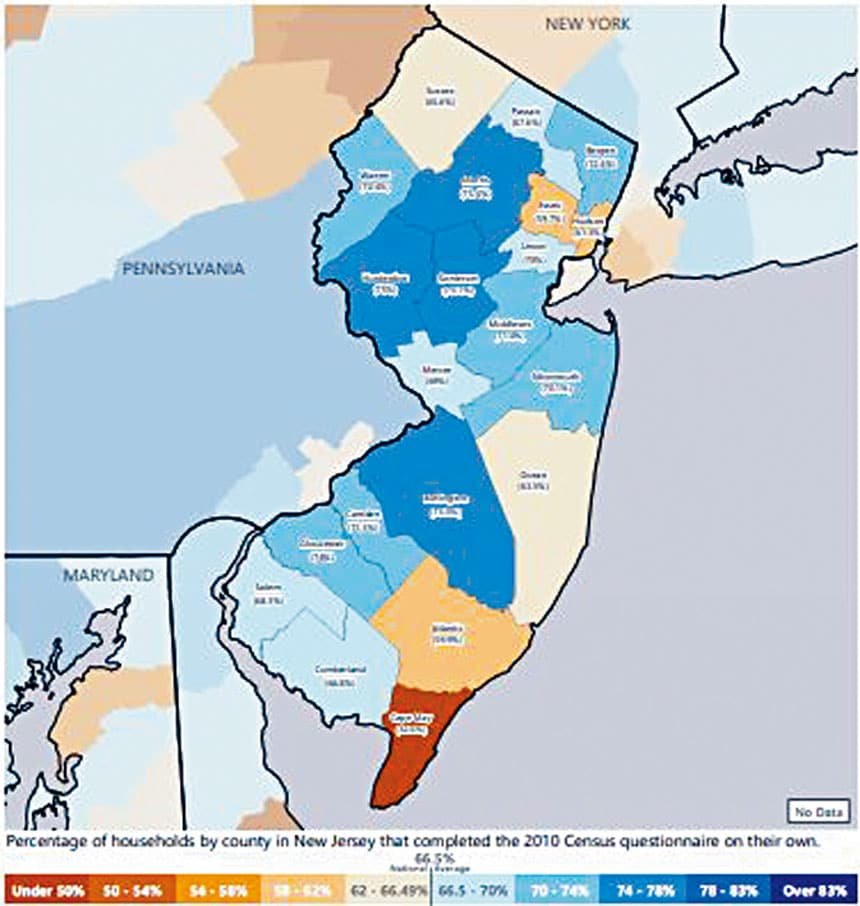By Ke “April” Xu, Sing Tao Daily
Editor’s note: This is the English translation of the original story, which was first published in Chinese for Sing Tao Daily. This version has been updated and edited, with permission from the author(s) and publication(s), for length and clarity.
——
BERGEN COUNTY—While the current data shows that the overall census count of Asian Americans in New Jersey looks promising, census experts noted that the disparities in response rates are clear between those living in affluent and low-income neighborhoods.
A phenomenon known as the “Matthew effect,” experts said, could lead to worse undercount of the state’s most vulnerable groups in the Asian American community.
To illustrate, in Essex County, where many Asian American families reside in wealthy areas, census tracts have an average response rate of 77.6%, outperforming the county average of 56.7%, as of July 21, 2020.
And in Hudson and Atlantic Counties, Asian Americans there show among the lowest response rates. As of August 6, according to HTC 2020 maps, Jersey City’s response rate was 50.5% and Atlantic City was merely 41.3%, compared to the state’s 65%.
“We’re still in the middle of the census, [and] it’s too early to say that the Asian American community is doing pretty well,” said Howard Shih, research and policy director of the Asian American Federation, a community group that is part of the NJ Census Media Counts initiative.
He pointed out that the coronavirus pandemic may compound the problem of getting a complete count in low-income Asian communities.
“Fort Lee, Edison—those areas tend to be civically engaged communities, and they are more likely engaged in the census as well. We are not surprised by that,” Shih said. “We are concerned about the pockets that are not being seen or served like Jersey City and Atlantic City.”
Transients and foreign students
In Jersey City, Shih said there are many international students from various Asian countries or new immigrants who work remotely, and they may have moved away because of the pandemic.
And in Atlantic City, there is a large number of Asians working at casinos and are now temporarily living out of state since the pandemic has shut down all entertainment and gambling businesses in the area.
About 87% of Asian families (59,942 people) in Jersey City live in hard-to-count areas, and 90% (6,394 people) in Atlantic City.
English proficiency and internet access
Peter Chen, policy counsel at Advocates for Children of New Jersey, has particularly expressed concerns about Asian immigrants who have limited English proficiency and have no internet access.
“Asians are pretty varied. There is a group in the Asian community that tends to have higher education and income levels than white population,” he said. “But there is also a group that is part of the low-income bracket and does not have enough education.”
In recent years, as more and more Asian families have moved from typical Asian enclaves like Chinatown, Koreatown or Little Manila, Chen said they now have been spread out all over the state. That makes it more difficult to know the exact response rate of those who live in areas where the population of Asians is small.
“For example, in the Chinese community, the English proficiency is different between someone who got a master’s degree from an American graduate school and someone who is a recent immigrant working at a restaurant or a garment factory,” said Chen. “A Chinese doctor who lives in Edison is much more likely to be responding to the census than a Chinese dishwasher at a restaurant in Jersey City.”
Community outreach is vital
The lack of community outreach, Chen added, is one of the biggest barriers for many Asian immigrants from engaging in the census.
“My biggest concern is that the in-language outreach for the census hasn’t necessarily reached the Asian populations. One of the things we hear frequently is that ‘we have seen a lot of English-language census materials, but we are not seeing a lot of materials in Chinese, Vietnamese or Korean,’” Chen said. “Even if the U.S. Census Bureau has some materials available, the question is how much did they get into the community?”
As a result, at least in New Jersey, it has created gaps in census response rates among Asian Americans based on their economic status, he noted. Those who have high education and income levels will be more likely to participate in the census. And those vulnerable groups in the Asian community will continue to face more challenges and they are less likely to be counted.
For those with limited English proficiency and having difficulty understanding some of the census questions, Chen suggested that responding by telephone would be the best option for them.
“If you call in, somebody can walk you through it in your language,” he said. “But the phone option is having very little usage. There have been 18 million responses nationwide by paper, and only 1.4 million by phone.”
This story was part of the “2020 Census: New Jersey Media Counts,” an initiative of the Center for Cooperative Media at Montclair State University.
Caption:
- According to Census 2010, Hudson County which Jersey City belongs to and Atlantic County which Atlantic City belongs to are among the lowest response rates areas. Courtesy of HTC 2020 Maps.

